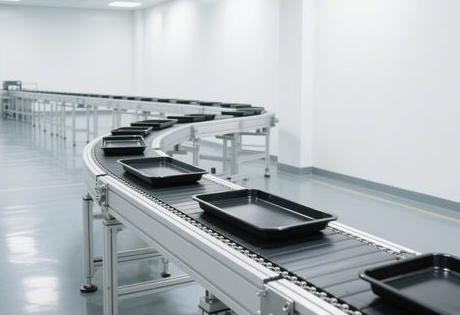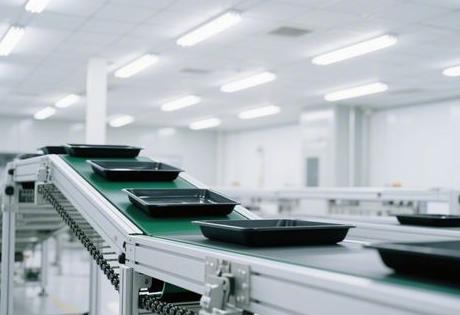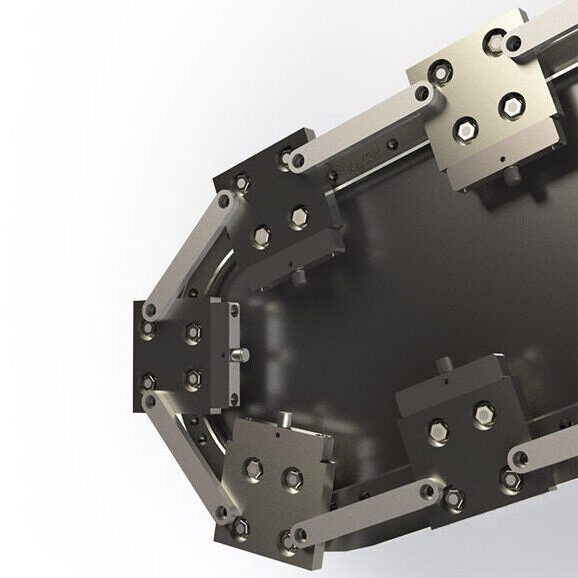Space revolution: the disruptive value of circular layouts
At a time when the cost of industrial land is soaring, ring multiplier chains are being used through theClosed-loop topologyRewriting the logic of production line space. The traditional linear production line needs to reserve 15%-20% return idle area due to the separation of the head and tail, while the ring design compresses the return section to the bottom of the load section to achieveSpatial folding in the vertical directionA Dongguan electronics factory test shows that: 80 metres of linear production line was reconstructed into a 15-metre circular line. An electronic factory in Dongguan measured show: 80 metres straight line was reconstructed for 15 metres ring line, in the same capacity to save land 62%. more critical is that the workstation around the ring track wascentripetal distributionIt has shortened the material distribution path by 40% and reduced the radius of operator movement to within 3 metres. This layout is particularly suitable for the transformation of old urban factory buildings - a Shanghai company transformed a 1940s textile workshop into an intelligent assembly line, increasing capacity density by three times while preserving the historical building structure.

Technical decoding: synergistic systems for ring multiplier chains
Compound Growth Rate Architecture
The core of the ring multiplier chain's growth rate isThree-stage power coupling::

- Mechanical Growth Layer: 2.5-3 times the base speed through the difference in diameter between the roller and the roller (v = (1 + D/d) x v₀)
- magnetic boost layer: The guideway is embedded in an electromagnetic coil that generates a travelling wave magnetic field, which pushes the conductive substrate of the workpiece to generate a Lorentz force.
- fluid barrierMicroporous air pressure guide forms 5μm air film, reducing the coefficient of friction to 0.02-0.05.
Dynamic control systems
The workboard carries theRFID chipReal-time communication with PLC, triggering three major intelligent responses:
- The blocker automatically adjusts the release interval according to the process length (±0.1s accuracy).
- Corner jacking device turns the load board 90° in 0.8 sec.
- Automatic compensation of current with load fluctuation, energy saving during light load period 35%
The Intelligent Leap: From Automation to Adaptation
The practice of Tesla's Shanghai factory reveals the evolutionary direction of the ring multiplier chain - when the production line integratesMachine vision positioning systemsAfter the body-in-white conveying speed of 96m/min still maintains ±0.05mm positioning accuracy. The key lies in:
- Distributed Edge Computing Nodes: AI inference unit deployed at each workstation to analyse workpiece position in real time
- Suppression of quantum tunnelling effects: Carbon nanotube shielding mesh (pore size ≤5nm) to block electron migration interference
- Phase Change Microencapsulated Coolant(PCM-ME) Absorbs 326J/g of heat at the friction hot spot.
This enables the production line to haveSelf-healing capacity of blockagesWhen a workstation is backlogged due to inspection delay, the subsequent workpieces are automatically accelerated and bypassed to the standby workstation, and the production line beat fluctuation rate is controlled within 2%.
Eco-evolution: flexible genes for cross-industry adaptation
The ring multiplier chain is penetrating from 3C electronics to diversified fields, and the key to its success is theModular Architecture::
| sector | Adaptation programme | Effectiveness Enhancement |
|---|---|---|
| New Energy Battery | Explosion-proof ceramic roller + static elimination device | Dust adsorption reduction 90% |
| medical equipment | Aseptic Work Plate + Negative Pressure Clean Chamber | Risk of biological contamination reduced to ISO Class 1 |
| Food packaging | Low temperature resistant chain (-30°C) + food grade lubricant | Extension of the shutdown clean-up cycle to 2,000 hours |
A PV company in Guangdong has customised the silicon wafers-cells-modules on a circular line to achieveThree-tier integrated productionIn addition, the traditional four-section production line was merged into a single line, and the logistics transit time was compressed from 45 minutes to 4 minutes.
Extreme Challenges: Paths to Breakthroughs in Technical Bottlenecks
The material fatigue paradox
The alternating stress on the chain during 16x operation is up to 7.8 times that of a conventional 3x line. The CAS team developed theZrO₂-TiC nanoceramic alloysthrough a gradient sintering process:
- Compressive strength up to 3.2 GPa (super tool steel 200%)
- Surface laser-etched honeycomb microcavity storage lubricant
- The coefficient of thermal expansion matches the steel up to 98%
The Energy Recovery Revolution
Berkeley Lab's innovative embedding of the bottom of the railPiezoelectric Ceramic Wafer ArraysThe chain vibration energy is converted into electrical energy:
- Average daily power generation 0.7kWh per metre of rail
- Meet the power needs of the Line Sensor 80%
- Shock absorption enhancement 40%
A picture of the future: the prototype of the superfluid factory
When the ring multiplier chain is deeply integrated with digital twins, it will give rise tofractal manufacturing network::
- material flow reconfiguration: Workpieces choose their own paths, and the traditional assembly line evolves into a dynamic production grid.
- dataflow synergy: 5G + edge computing enables millisecond-wide synchronisation of process parameters
- closed loop energy flow: Vibrational energy - electrical energy - mechanical energy to form a trinity cycle
Denso's pilot plant in Japan has proven its value - in mixed-line production processing 48 different engine models.Dynamic reorganisation efficiencyThe changeover time has been reduced from 27 minutes to 9 seconds, an increase of 17 times. This is a clear indication that the ring speed chain is not only a conveying tool, but alsoSpatio-temporal coordinators for smart manufacturing systems.

Ask yourself the core question.
Q: How to solve the waste of space in the traditional linear production line?
A: Through the closed-loop design, the return section is stacked under the load-bearing section, combined with the centripetal layout of the workstations to achieve a reduction in land use by 60% + a shortening of the logistics path by 40%.
Q: Why does the use of ring speed chains in the medical industry require special design?
A: It is necessary to implant a negative pressure clean chamber to prevent biological contamination, and the surface of the work plate is changed to antibacterial composite material, and the precision is required to reach ±0.1mm level.
Q: What is the breakthrough in thermal management under 16x operation?
A: The phase change microencapsulated coolant (PCM-ME) is used, which accurately vaporises and absorbs heat at 75°C, with a volume expansion of only 1.7%.













